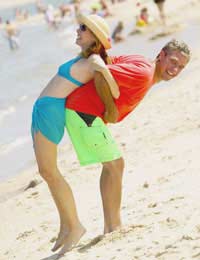Functions of the Spine

The spine has many functions in providing humans with the ability to lead the lives they do.
Strength and Support
The spine provides strength and support for the remainder of the human body with particular attention to the heavy bones of the skull.The thoracic region of the spine is particularly responsible for the task of offering strength and stability to the body. The lumbar region has the job of carrying most of the body’s weight and allows for movements of flexion but not rotation.
The spine and its curvaceous nature coupled with the array of muscles and tendons, provide our bodies with a method of being able to distribute our weight, and adapt to our changing bodies such as weight gain or pregnancy. During times of carrying extra weight the curves of the spine become more marked in order to for the body to balance by finding the centre of gravity and maintaining it. The presence of muscles, ligaments and tendons allow for this flexibility.
Movement
The intricate design of the spine and its accompanying structures of muscles, tendons, ligaments etc, permit the body to move in ways such as bending, stretching, rotating and leaning.The cervical spine is responsible for allowing movement and rotation of the head and neck, due to the presence of the first two cervical vertebrae, the atlas and axis, a unique combination of bones.
Protection of Nerves
The spinal column provides reliable protection of the delicate nerves and the spinal cord, without which humans could not function, as certain nerve impulses control the functions of our major organs. The design and placement of the vertebrae and certain ligaments form a network of protection that keeps the spinal cord from getting injured.Blood Supply
The vertebrae provide plenty of bone to produce red blood cells and minerals from within the hollow interior chamber of the bone, known as bone marrow. There are two types of bone marrow; red and yellow. Red bone marrow is responsible for the production of red blood cells, platelets and white blood cells, while yellow bone marrow contains high levels of fat cells and also produces some amounts of white blood cells.Protection of Major Organs
The skeleton allows a base for the ribs to attach which surround and protect our major organs. The term ribcage is actually defined as being the sternum (breast bone), 12 pairs of ribs and the 12 thoracic vertebrae. All human ribs attach to the spine, but only the upper 7 pairs attach to the sternum. The ribs form the cage of protection around the heart and lungs.Absorption of Impact
The spine provides a way of absorbing impact by containing intervertebral discs. These discs are situated between each vertebrae and as well as preventing the vertebrae from ‘bumping’ into each other, they contain a substance that absorbs forceful motion preventing the impact from being transferred to the next vertebra, much like a shock absorber.Other Functions
The spine provides a means of connecting the upper and lower body via the sacrum which connects the spine to the pelvis.The coccyx does not have a useful function in modern mankind.Newborn babies have fairly straight spines, and it isn't until they begin to hold the weight of their head independently, that the spine develops its characteristic curves.


Re: Who is at Risk of Developmental Back Pain?
I have been getting muscle spasms in my lower back for 30 years and when they occur I walk like an old man. I…
Re: A Spinal Tap Caused My Back Pain
When I was 14 I was sent to the emergency room with an illness the doctors couldn't identify. Extremely high fever and high…
Re: A Spinal Tap Caused My Back Pain
I've had spinal meningitis 7 times now. So much scar tissue they have to do x ray with the lumbar puncture. I am having a lot…
Re: A Spinal Tap Caused My Back Pain
Hello I had spinal tap done bout 8 month ago due to a brain aneurysm. I tell you someday they way my back is make me not…
Re: A Spinal Tap Caused My Back Pain
So about 7 or 8 months ago I got a spiral tap preformed due to have being diagnosed with Idiopathic intracranial…
Re: A Spinal Tap Caused My Back Pain
So about 7 or 8 months ago I got a spiral tap preformed due to have being diagnosed with Idiopathic intracranial…
Re: Dehydrated Discs
hI THERE, I have Dyhydration L3/l4 and ll4/l5 and disprotrusion and sequestrated discu after MRI i am aged 52. I had hip pain all night for 3…
Re: A Spinal Tap Caused My Back Pain
Hi . I also had a spinal Tap to check the stages of a bleeiding in my brain. This has caused me serious back pain almost…
Re: Dehydrated Discs
Alex - Your Question:I am a 27 yr old male who up until last year was working 84-108 hrs/week and always had back problems but all the doctors I…
Re: Dehydrated Discs
I am a 27 yr old male who up until last year was working 84-108 hrs/week and always had back problems but all the doctors i had seen told me its…